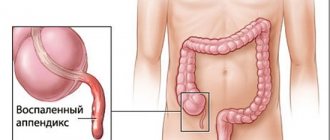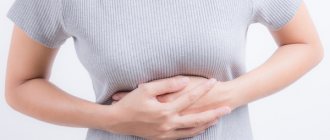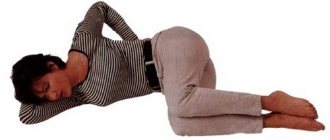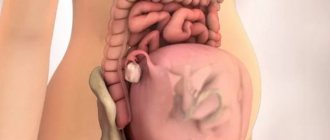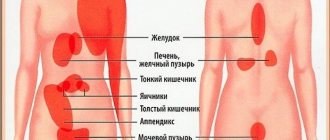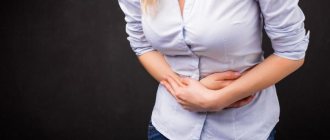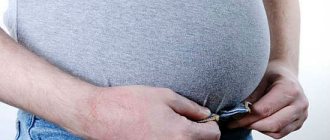Causes of pain
The intestines occupy most of the abdominal cavity. At the very bottom of the abdomen is the large intestine and rectum, part of the small intestine. It is the pathologies and diseases of these organs that lead to pain in the intestines.
Symptoms of intestinal diseases manifest differently in women and men, but pain is always the first sign.
The reasons for its occurrence are as follows:
- Insufficient production of gastric juice as a result of which food is not completely digested and begins to cause fermentation processes in the intestines, and then discomfort and pain.
- Something from the outside is pressing on the intestines - a tumor in the abdomen or a growing fetus in a pregnant woman. Then the intestines do not hurt constantly, but the pain itself can be different - from acute and short-term to dull and lasting for a long period. Most often, the large intestine is affected by such problems.
- Intestinal diseases can be completely different, affecting the entire intestinal tract (IBS, enterocolitis, etc.), or a certain part of it (colitis, appendicitis, diverticulitis, etc.). Pain in the intestines will manifest itself in a variety of ways, depending on why it occurs.
- The intestines may suffer due to diseases of neighboring organs when the inflamed area begins to grow and affect nearby tissues. The process can cover the entire abdominal cavity - from the top to the bottom of the abdomen.
It is very important to identify the cause of intestinal pain before starting treatment. Due to incorrect diagnosis and therapy, complications can arise, because if you treat ordinary colic with the wrong pills, then it won’t take long to provoke diarrhea with dehydration, or worse.
You should also make sure that the lower abdomen hurts due to intestinal pathology, and not any other neighboring organs - bladder, uterus, prostate, stomach, abdominal muscles, etc. It is worth figuring out whether another organ can hurt for natural reasons (menstruation, pregnancy), and only then begin to consider the intestines as an object of pain.
Nature of pain and pathology
Pain in the intestines can be:
- Acute;
- Dumb;
- Sharp;
- Cutting;
- Pulling;
- Bursting;
- Pressing;
- Burning;
- piercing;
- Aching;
- Paroxysmal (cramping);
- Lingering.
Intestinal pain often comes in several types at the same time - it will sting in the side, then it will begin to pull and burn. The tingling sensation can be felt for a long time, and then disappears completely, but will be replaced by aching sensations throughout the abdominal area. Stitching and cutting pains can be sharp and occur in attacks, while nagging pains will ache and haunt a person for a long time. And there are a lot of such options.
The nature of the pain often indicates to the specialist the range of searches, since each pathology of the intestinal tract is characterized by a certain type of pain. You can see the most common options in the table.
| Nature of pain | Diseases and pathologies |
| Cramps in the intestines | Observed in irritable bowel syndrome, ulcerative colitis of nonspecific etiology, diverticulitis |
| Bursting and pressing pain | It may seem that the intestines are bursting from the inside with gastritis or eating very heavy foods, especially salty foods |
| Dull nagging pain | Intestinal obstruction, tumors in the intestine or outside near it, pressure of the growing uterus on the intestines, chronic inflammatory process, pancreatitis |
| Cramping pain, as if cutting the stomach from the inside | Helminth infections, damage to the intestinal walls from swallowed hard and sharp objects, foodborne toxic infections, coronary disease |
| Acute pain (sometimes sharp and dull, but does not last long) | UC, appendicitis, infectious diseases of the intestinal tract |
There are other intestinal pathologies that cause pain in the lower abdomen, but they often do not have a specific characteristic to describe the pain that occurs.
Enteritis can cause sharp pain during an exacerbation period, or during a chronic period, the stomach simply pulls and aches. With colitis, constant pain is often observed, but it is expressed either stronger or weaker. Therefore, not all pathologies can be determined only by the nature of the pain.
Causes of pain in the intestines in the lower abdomen
Medical experts identify several causes of severe pain in the lower abdomen:
- Appendicitis.
With appendicitis, the patient experiences severe nagging pain in the right side of the abdomen. Pain syndromes intensify during sudden movements. At first, the pain disturbs the patient throughout the middle region of the stomach, later it appears in the lower abdomen and concentrates on the right.
The pain intensifies when turning from one side to the other, when walking or coughing. Over time, tension will arise below, which is an important signal to go to the hospital. The person will constantly feel sick, the temperature and blood pressure will rise, there will be an appetite disorder, and loose stools.
- Irritable bowel syndrome.
With irritable bowel syndrome, the patient is bothered by acute sharp pain in the intestinal area, stool is disturbed, and the temperature rises. Symptoms disappear after a few days. If the patient's condition has not improved, it is advisable to consult a doctor. The disease has entered a chronic stage.
- Problems with the uterus and female genital tract.
In female patients, acute pain in the intestines in the lower abdomen indicates the development of the disease in the uterus and in the female genital tract. It is advisable to contact a gynecologist as soon as possible to stop the inflammatory process. Such symptoms can lead to infertility if not properly treated.
- Impaired blood circulation in other organs.
Acute pain in the intestines in the lower abdomen indicates a violation of blood circulation in other organs. Problems can be found not only in the body's gastrointestinal tract, but also in other systems.
- Functional changes in the intestines or other organs.
- Violation of cellular metabolism in the intestine.
- Crohn's disease.
Crohn's disease is an inflammatory process that is accompanied by severe acute pain in the lower abdomen.
Localization and time of pain
The concept of “lower abdomen” already reduces the range of searches for a specialist in the causes of pain, but it can be further narrowed:
- There is pain below the navel due to inflammation of the small intestine.
- On the left side of the abdomen it hurts with dysentery and other infectious diseases. Also, pain on the left side is characterized by inflammation of the sigmoid and colon.
- At the bottom right, the intestines can hurt due to appendicitis and other diseases of the cecum.
- If the entire lower abdomen hurts (usually a dull pain), then it looks like a general inflammation of the intestinal tract or a peptic ulcer.
In addition to the location of the pain, the time of its manifestation will also help to make a diagnosis. She can:
- Appear after bowel movements (typical of hemorrhoids).
- Worse when walking (appendicitis).
- Occur or intensify before defecation (inflammation of the intestinal walls).
- Appear in the morning or evening, depending on the schedule of the intestines (the stronger the peristalsis, the more pain, if the cause is spasms).
- Occur after eating immediately or after 30 minutes (gastritis, gastroenterocolitis, peptic ulcer).
- It does not appear immediately after eating, but after a couple of hours, especially if a person has consumed large amounts of roughage (intestinal tumor).
Constant pain in the lower abdomen can drive anyone crazy. Therefore, it is necessary to consult a doctor as soon as possible and mention the nature, location and time of pain, what this may be associated with, so that the specialist can quickly establish a diagnosis and begin treatment.
Associated symptoms
Pain occurs first most often, but sometimes it simply gives a reason to think and remember whether there were other symptoms of pathology that were simply not paid attention to.
Pain in the lower abdomen with intestinal pathology may be accompanied by:
- Temperature up to 39˚С;
- Loose stools and diarrhea;
- Hard feces and stool retention - constipation;
- Bloating and flatulence;
- Tight or overly soft belly;
- Nausea and vomiting;
- False urge to defecate;
- Discomfort during bowel movements;
- Heaviness in the stomach after eating;
- A feeling of incompleteness after defecation;
- Dehydration, accompanied by pallor and dryness of the skin and mucous membranes;
- The appearance of mucous or blood impurities in the stool;
- General malaise and increasing fatigue.
Video
These symptoms will help the specialist narrow down the range of diseases that cause pain in the intestines in the lower abdomen. Therefore, when visiting a doctor, you should definitely mention all even minor symptoms.
Causes of pain in the lower abdomen
If discomfort occurs in the lower part of the body, it is important to determine the nature of the pain and symptoms in order to properly treat the disease. Depending on the root cause, the doctor may prescribe one or another remedy. No less important is the provoking factor (cause), which caused a dull, pulling, cutting pain below. As a rule, it lies in the intestines, which ceases to function properly:
- Overeating food. If, an hour after eating, along with a feeling of oversaturation and unpleasant belching, pain appears in the intestines in the lower abdomen, this indicates a weakness in the digestive process. This happens due to low acidity, the stomach does not have enough gastric juice, which leads to incomplete digestion of food, which over time begins to ferment and cause discomfort.
- Sometimes the intestines in the lower abdomen hurt from stress. This is possible in the presence of constant irritation factors that provoke the occurrence of ulcerative colitis. Pain in the intestines in the lower abdomen is dull, aching, and sometimes radiates to the left side. Symptoms of the disease include false urge to defecate, blood in the stool, fever, diarrhea, and general weakness.
- Pain in the rectum and lower abdomen during menstruation is associated with an increase in blood flow to the pelvis. This can provoke stagnation in girls who are predisposed to the development of varicose veins. This occurs with decreased vascular tone and severe weakness of connective tissue. Congestion is characterized by nagging unpleasant sensations, pain during bowel movements, protrusion of hemorrhoids, and constipation.
- Some pathologies are characterized by pain in the intestines in the lower abdomen. These, for example, include diverticulitis, which occurs when there is inflammation in the areas of protrusion of the colon. Unpleasant sensations occur when feces and food stagnate in these areas. Intestinal pathology also includes the appearance of tumor formations. These could be polyps (benign) or colon cancer. At the very beginning, the sensations are not very pronounced, but after growth the neoplasm blocks the lumen and symptoms of intestinal obstruction occur (colic, stabbing pain, constipation).
- Frequent urination without pain in men
- Fried chanterelles: recipes
- Myasthenia - what is it? Forms and causes of occurrence, symptoms and treatment of myasthenic syndrome
How to determine the cause?
To establish the cause of pain in the lower abdomen, it is necessary to undergo examination by a gastroenterologist.
His actions will be like this:
- Collecting anamnesis about symptoms and time of onset of the disease.
- Finger diagnostics.
- X-ray or ultrasound of the abdominal cavity.
- Colonoscopy.
The first three points are usually carried out without fail, and the fourth is prescribed if up to this point in the diagnosis the cause has not been established.
Also, colonoscopy can be indicated simultaneously as a diagnostic and therapeutic measure. During the procedure, you can take pieces of tissue for examination, remove a polyp or small tumor, cauterize the bleeding site, etc. Along the way, other examinations of nearby organs may be needed for diagnosis, if along the way it turns out that the problem is not in the intestines at all.
What to do?
Diagnosis should be carried out exclusively by a specialist, because if you make a diagnosis yourself, you can make a mistake and start inappropriate treatment. Having established the cause, you can begin treatment of the disease. These will be special drugs that help heal a person and improve the functioning of his intestines. Massage or compresses can also help relieve pain.
Drug therapy
If a person refuses diagnosis or knows why pain in the lower abdomen occurs, then you can take drugs from certain groups:
| Group of drugs | Action | Examples |
| Antispasmodics | Relieve muscle spasms, eliminate pain, relax smooth muscles | No-shpa, Spazmolgon, Metoclopramide, Papaverine |
| Laxatives | Softens and pushes stool, reducing pressure in the intestines, thereby eliminating pain | Duphalac, senna leaves, Normaze, Guttalax, magnesium sulfate, Microlax |
| Adsorbents | Remove symptoms of intoxication, remove toxins and ease bowel function | Activated or white carbon, Enterosgel, Smecta |
| Anthelmintics | If pain in the intestines is caused by parasites, then you should choose the right medicine and drive away the worms, after which everything will work out | Wormil, Vermox, Dekaris |
It is advisable to take pain medication as prescribed by your doctor. Yes, if the pain is not severe and stops immediately after taking antispasmodics, then there is nothing to worry about. But if the drugs do not help, the pain intensifies, then you should immediately seek medical help.
Cold or warm
If pain in the lower abdomen is caused by intestinal spasm, you can apply a warm heating pad.
But during the inflammatory process, this method will only worsen the situation. A heating pad with ice will help temporarily relieve pain, but this method only dulls the feeling of pain and does not heal, and it can also cause colds in other organs, especially the genitourinary system.
Massage
A light massage of the abdomen in a clockwise direction sometimes relieves pain if it is caused by stagnation of food in the intestines or colic. But the procedure should be carried out very carefully, do not press hard, you need to move your hands in several circles and then press the navel a couple of times. If the pain is severe, cutting, sharp, then massage should not be done.
What to do to relieve pain
It is not worth enduring pain, especially acute pain.
Before going to see a doctor, you need to give yourself first aid:
- take an antispasmodic drug - “No-shpu”, “Drotaverine”, etc. and lie down for a while, the spasm should subside within half an hour;
- if the cause of pain in the intestines is a failure of defecation, it is recommended to take a sorbent drug (activated carbon);
- Glycerin suppositories or Microlax enema will help eliminate constipation.
Self-massage sometimes helps relieve pain in the lower abdomen. Some people are saved by physical exercises specially designed for this purpose . In case of frequent pain, food is temporarily removed from the diet and the volume of fluid consumed is increased (up to 2 liters per day).
All other appointments must be made by a doctor. But under no circumstances should you apply a cold compress or a warm heating pad to your stomach.
How to prevent pain?
Pain in the lower abdomen can be avoided if you monitor the functioning of your intestines and try to prevent the occurrence of pathologies and diseases.
The following can help with this:
- Proper nutrition. Food should be easily absorbed by the body, be at room temperature or slightly warmer, so as not to cause pain. It is also advisable to enrich the diet with foods with fiber and pectins, which will help improve intestinal function and promote better absorption of food.
- Sufficient amount of clean water. Plain water without gas will not only help restore balance if you have a digestive problem, but will also soften the stool, thereby facilitating its passage through the intestines. If the feces do not burst the intestines from the inside, there is no stagnation, then pain in the lower abdomen will not bother you.
- Exclusion of harmful products. Coffee, alcohol, fast food, spices - all this worsens the functioning of the intestines and leads to the development of foci of inflammation, which already cause pain. You should limit yourself to such products and then there will be fewer risks.
- Compliance with basic hygiene rules. Clean hands and food – no worms.
- Routine medical examinations. If you identify the disease at the very beginning of its development, then many unpleasant symptoms can be avoided even before they appear. Therefore, you should not neglect going to the doctor and delay visiting hospitals.
At what point should you call an ambulance?
A diseased intestine can manifest itself in different ways, but there are symptoms that should not be ignored, since any delay can be fatal for a person.
Signs that require immediate medical attention include:
- Nausea in a fountain of brown or black color.
- Severe dehydration.
- Cramps.
- Loss of consciousness due to pain in the lower abdomen.
- Large amounts of feces with blood.
- Watery stools more than 10 times a day.
- Increase in body temperature to 40˚C.
- Very tight abdomen, the intestines cannot be palpated upon palpation.
- After several days of severe pain, it suddenly subsides, and the stomach becomes soft and insensitive.
- Complete refusal of food and drink.
If such symptoms accompany pain in the lower abdomen, you should immediately call an ambulance, otherwise the person may face unforeseen consequences. If the intestines in the lower abdomen hurt for a long time and persistently, and pills do not help, then you should make an appointment with a gastroenterologist and undergo an examination to find the cause of the pathology, and only then begin treatment.
Associated symptoms or when to see a specialist
To definitively diagnose a gastrointestinal disease, the doctor specifies other symptoms accompanying the pain.
The most common ones are:
- nauseating urge to vomit;
- feverish chills with increased temperature;
- diarrhea or, conversely, difficult bowel movements;
- false urge to defecate;
- bloating with the formation of gases in the intestines;
- pain appearing in other parts of the abdominal cavity;
- blood clots or mucus impurities that appear in the stool.
All these signs against the background of painful sensations in the lower abdomen are already a reason to consult a doctor. To these should also be added dryness or bitterness in the mouth, increased salivation, drowsiness, loss of strength, and decreased performance.

